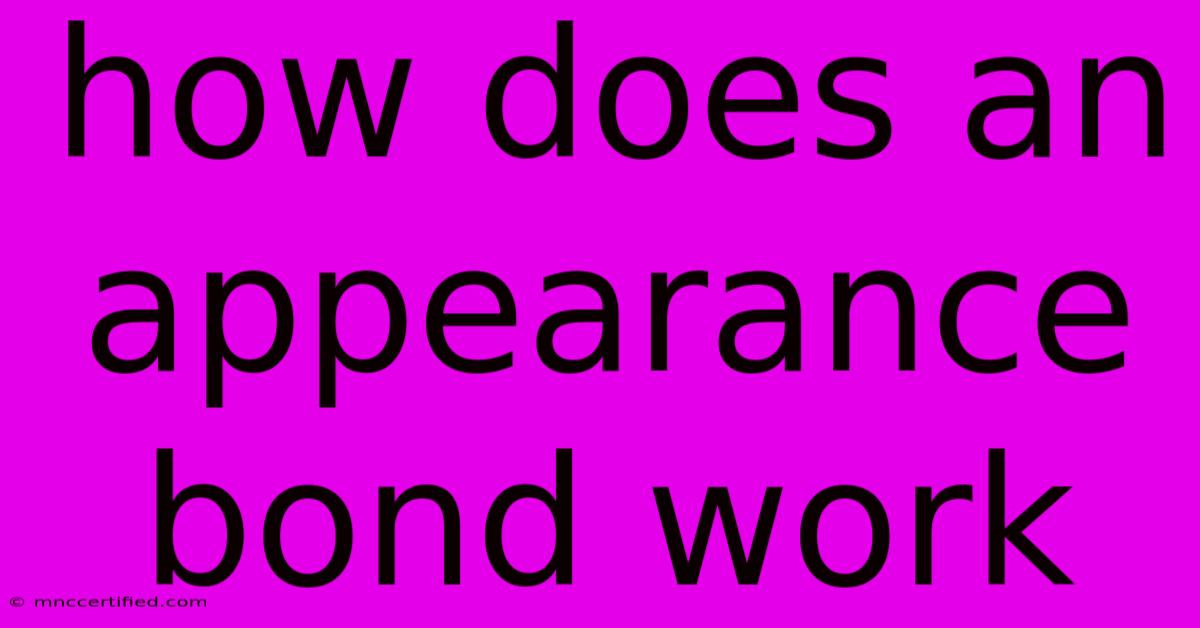How Does An Appearance Bond Work

Table of Contents
How Does an Appearance Bond Work? A Comprehensive Guide
Understanding the complexities of the legal system can be daunting, especially when facing charges and navigating the intricacies of bail. One crucial aspect of this process is the appearance bond. This comprehensive guide will demystify how appearance bonds work, explaining their purpose, the process involved, and the potential consequences of violating the terms.
What is an Appearance Bond?
An appearance bond is a type of bail bond that guarantees a defendant's appearance at all required court proceedings. Essentially, it's a promise, secured by money or property, ensuring the defendant won't flee before the case concludes. The bond serves as an incentive for the defendant to attend court hearings, preventing them from skipping town and avoiding justice. Failure to appear results in forfeiting the bond amount.
Key Players in the Appearance Bond Process:
- The Defendant: The individual charged with a crime.
- The Court: The judicial body overseeing the case.
- The Bondsman (or Surety): A licensed professional who posts bail on behalf of the defendant. (Not always involved, depending on the type of bond.)
- The Bail Agent (or Bail Commissioner): A court official who determines the amount of bail.
How Does the Appearance Bond Process Work?
The process generally unfolds as follows:
- Arrest and Charges: Following an arrest, the defendant is brought before a judge or magistrate.
- Bail Determination: The judge sets a bail amount, considering factors like the severity of the crime, the defendant's criminal history, and the risk of flight.
- Bond Posting: The defendant, or a bondsman on their behalf, posts the required amount to secure the release. This can be in cash, property, or through a surety bond.
- Release from Custody: Upon posting the bond, the defendant is released from jail pending their court appearances.
- Court Appearances: The defendant is legally obligated to attend all scheduled court hearings.
- Bond Return: If the defendant fulfills all court obligations, the bond is returned at the conclusion of the case.
Types of Appearance Bonds:
While the core principle remains the same, appearance bonds can vary:
- Cash Bond: The defendant pays the full bail amount in cash. This is refunded upon completion of the court proceedings.
- Property Bond: The defendant uses property as collateral. The court retains ownership until all court appearances are met.
- Surety Bond: A bondsman posts the bail amount on behalf of the defendant. The defendant typically pays a premium to the bondsman, usually a percentage of the total bail. The bondsman assumes responsibility for the defendant's appearance.
Consequences of Failing to Appear (FTA)
Failing to appear in court is a serious offense with significant consequences:
- Forfeiture of the Bond: The entire bond amount is forfeited, meaning the money or property used as collateral is lost.
- Warrant for Arrest: A warrant will be issued for the defendant's arrest, making them a fugitive from justice.
- Increased Charges: The defendant may face additional charges and penalties for contempt of court.
- Difficulty Obtaining Future Bonds: It will be significantly harder to obtain bail in future cases.
Choosing the Right Appearance Bond
Selecting the appropriate type of appearance bond depends on individual circumstances and financial capabilities. Consulting with a legal professional is crucial to understand the implications of each option. They can advise you on the best course of action, helping you navigate the legal process effectively.
Keywords for SEO Optimization
This article incorporates keywords such as: appearance bond, bail bond, surety bond, cash bond, property bond, bail, court appearance, FTA (failure to appear), defendant, judge, bondsman, legal process, court proceedings, release from custody, forfeiture of bond, consequences of FTA, choosing the right bond, legal professional. These keywords are used naturally throughout the text to improve search engine optimization. The use of headers and bold text further enhances readability and SEO. Remember to build backlinks to this article from other relevant websites to boost its off-page SEO.

Thank you for visiting our website wich cover about How Does An Appearance Bond Work. We hope the information provided has been useful to you. Feel free to contact us if you have any questions or need further assistance. See you next time and dont miss to bookmark.
Featured Posts
-
Nj Drone Incident Under Investigation
Nov 20, 2024
-
Corgi James Bond Cars Collection
Nov 20, 2024
-
Linda Mc Mahon Trumps Wwe Choice
Nov 20, 2024
-
Is Fundrise Ipo A Good Investment
Nov 20, 2024
-
Booker Winner Adds New Prize
Nov 20, 2024